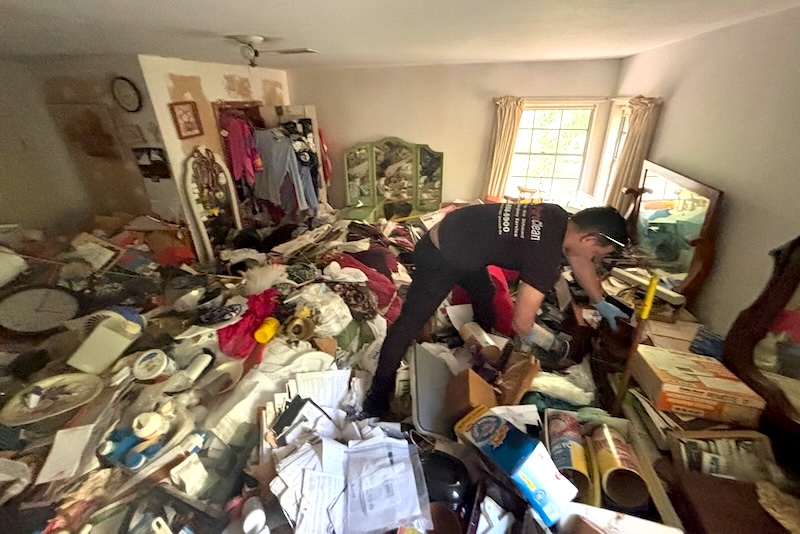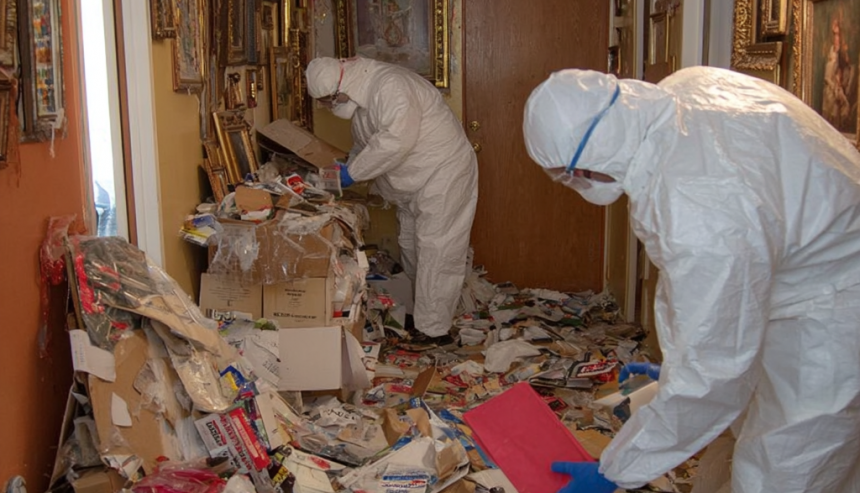Hoarding is a mental health condition in which a person feels a strong need to save a large number of items and experiences significant distress when trying to part with them, according to ClevelandClinic.org. This emotional attachment can make it incredibly difficult to discard even seemingly insignificant objects, often reinforcing ongoing cycles of anxiety, isolation, and emotional distress.
In Sugar Land and the surrounding Houston area, hoarding effects about 2.6% of the population, making it more common than one might assume. What may begin as simple collecting can quickly grow into unmanageable living conditions. Hoarding can pose serious health and safety risks, damage relationships, and create feelings of helplessness for everyone involved.
In Sugar Land and surrounding areas, where heat, humidity, and seasonal storms are part of daily life, the risks associated with hoarding disorder can quickly escalate. The environments created by hoarding don’t just affect the individual—they endanger family members, neighbors, and even first responders.
At PuroClean of Sugar Land, we’ve seen firsthand how hoarding can spiral into dangerous living conditions. Here are some of the most serious risks associated with hoarding in our community:
🔥 Fire Hazards
Excessive clutter—especially flammable materials like paper, fabric, and cardboard—creates a heavy fire load. In many Sugar Land homes affected by hoarding, exits are blocked, electrical outlets are overloaded, and HVAC vents are obstructed, significantly increasing the risk of a fast-spreading fire. These conditions not only endanger the occupants but also hinder emergency responders trying to help.
⚠️ Fall Hazards
Stacked items create narrow or blocked walkways, increasing the likelihood of trips and falls. This is especially dangerous for seniors or anyone with mobility challenges—a common concern in many of Sugar Land’s multi-generational households.
🌬️ Poor Air Quality & Respiratory Problems
In a humid environment like Sugar Land, poor ventilation—caused by blocked windows and vents—can lead to a buildup of dust, pet dander, mold spores, and allergens. For residents with asthma, allergies, or other respiratory conditions, this can result in chronic health issues and frequent medical visits.
🐜 Pest Infestations
Hoarding conditions often attract pests such as cockroaches, ants, rodents, and even bed bugs. The presence of food scraps, damp corners, and cluttered hiding spots provides the perfect breeding ground for infestations that can spread disease and damage property.
🏚️ Structural Damage
The sheer weight of accumulated items in Sugar Land homes—especially on upper floors—can strain floors, ceilings, and walls. Water damage from hidden leaks or blocked plumbing may go unnoticed, leading to mold growth and long-term structural issues.
🚱 Sanitation Concerns
In extreme hoarding cases, kitchens and bathrooms may become inaccessible, making it difficult for residents to maintain basic hygiene. Spoiled food, dirty dishes, and limited access to clean water increase the risk of illness and bacterial contamination.
😔 Mental and Emotional Decline
Living in hoarded conditions can lead to increased feelings of shame, isolation, and anxiety. Many individuals withdraw from friends, family, and community life in Sugar Land, avoiding visitors due to embarrassment or fear of judgment—further deepening emotional distress.
At PuroClean of Sugar Land, we understand that hoarding is a complex mental health issue—not just a cleanup problem. Our team approaches each situation with compassion, discretion, and professionalism. Safety comes first, followed by a carefully structured plan to help restore not just the home, but also a sense of dignity and peace for everyone involved.
Does Insurance Cover Hoarding Cleanup in Sugar Land?
At PuroClean of Sugar Land, we’re often asked whether homeowner’s insurance will cover the cost of cleanup related to hoarding. The truth is, this can be a complicated issue—and in most cases, insurance doesn’t directly cover hoarding as a condition.
Homeowners insurance typically focuses on sudden, accidental damage—not long-term issues caused by neglect, poor maintenance, or gradual deterioration. Since hoarding often involves conditions that develop over time, coverage is usually limited. However, there are exceptions based on the specific circumstances and your individual policy.
Here’s how different types of damage related to hoarding might be handled:
💧 Water Damage
If a pipe bursts unexpectedly—say, due to freezing or a plumbing failure—the resulting damage may be covered. However, if clutter prevents proper cleanup or the leak goes unnoticed for weeks because it’s hidden behind piles of items, the insurance company might deny part or all of the claim, citing delayed response or gradual damage.
🔥 Fire Damage
If a fire originates from an outside source (like a lightning strike) and the damage is worsened by the excessive contents in the home, the fire damage itself could still be covered. But if the fire results from overloaded outlets—a common problem in homes with heavy hoarding—the insurer may question negligence, which could limit or deny the claim.
🦠 Mold Issues
Mold caused by a sudden, covered water event might be included in your policy. However, if mold forms due to long-term dampness, poor airflow, or neglected maintenance tied to hoarding conditions, coverage is unlikely.
What You Can Do:
- Carefully review your insurance policy to understand what’s covered and what’s not.
- Contact your insurance agent promptly if damage occurs.
- Document everything—photos, timelines, and affected areas.
- Partner with a professional team, like PuroClean of Sugar Land, to assess the situation and provide detailed documentation for your claim.
While we can’t guarantee coverage, our job is to make the cleanup and restoration process as smooth, safe, and stress-free as possible. We’re here to support Sugar Land homeowners through difficult situations with professionalism, discretion, and compassion.
Supporting a Loved One Who Doesn’t See the Problem

One of the hardest parts of dealing with hoarding in the family is when your loved one doesn’t believe there’s an issue. When someone is in denial about their hoarding behaviors, pushing too hard or criticizing their living conditions often leads to frustration, arguments, and withdrawal.
Instead of focusing on the mess, it’s important to lead with understanding, patience, and empathy. Here are some ways to approach the situation with compassion and purpose:
📘 Learn Before You Act
Before addressing the issue, take time to understand that hoarding is not about laziness or poor choices—it’s a complex mental health condition. Educating yourself about the psychological side of hoarding, especially from trusted sources like the International OCD Foundation, helps you shift your mindset from frustration to empathy.
💬 Talk About Safety, Not Clutter
Instead of pointing out how messy the home is, try bringing up specific concerns that relate to their health and well-being. For example:
- “I’m nervous about you tripping over something.”
- “I’ve noticed the air feels stuffy, and I worry about your breathing.”
These kinds of comments are usually received better and feel less like criticism.
❤️ Speak From the Heart, Not From Judgment
Try using “I” statements to express how you feel. Saying, “I care about you and want to help,” is much more effective than, “You have to get rid of this stuff.” Avoiding blame or threats can help prevent defensive reactions and keep the conversation open.
👂 Really Listen
Hoarding isn’t just about physical things—it’s emotional. The items may hold deep meaning for your loved one. Give them a chance to talk. Ask open-ended questions like, “Can you tell me more about this?” and listen without jumping in with solutions right away.
🧠 Encourage Mental Health Support
Since hoarding disorder is rooted in emotional and psychological struggles, professional help is often essential. You might suggest talking to a licensed therapist who specializes in hoarding behaviors or cognitive-behavioral therapy (CBT). Offering to help them find someone—or even going to the first session—can lower the barrier to getting started.
🧹 Start Small, Go Slow
Don’t expect to clean out an entire home overnight. Choose one small, manageable task—like clearing a walkway or a corner of a room—and work together. Celebrate small wins to build momentum and trust.
✅ Respect Their Choices (While Staying Safe)
It’s important to balance safety concerns with respect for your loved one’s autonomy. Instead of throwing things out, suggest sorting items into groups: things to keep, donate, recycle, or discard. Let them take the lead where possible, so they feel in control of the process.
Closing thoughts on Hoarding

In Sugar Land and beyond, helping someone with hoarding disorder requires more than just good intentions—it takes patience, empathy, and the right kind of support. Change doesn’t happen overnight, but with consistent care and professional guidance, progress is possible.
At PuroClean of Sugar Land, we’ve helped many families navigate the challenges of hoarding cleanup with empathy, skill, and discretion. If you’re facing this situation, know that you don’t have to do it alone. We’re here to help—every step of the way. If someone you care about is struggling with hoarding, you don’t have to face it alone. PuroClean of Sugar Land South offers compassionate, confidential, and expert cleanup services designed to restore safety and dignity to any living space. Reach out to our team at (281) 916-2002.
